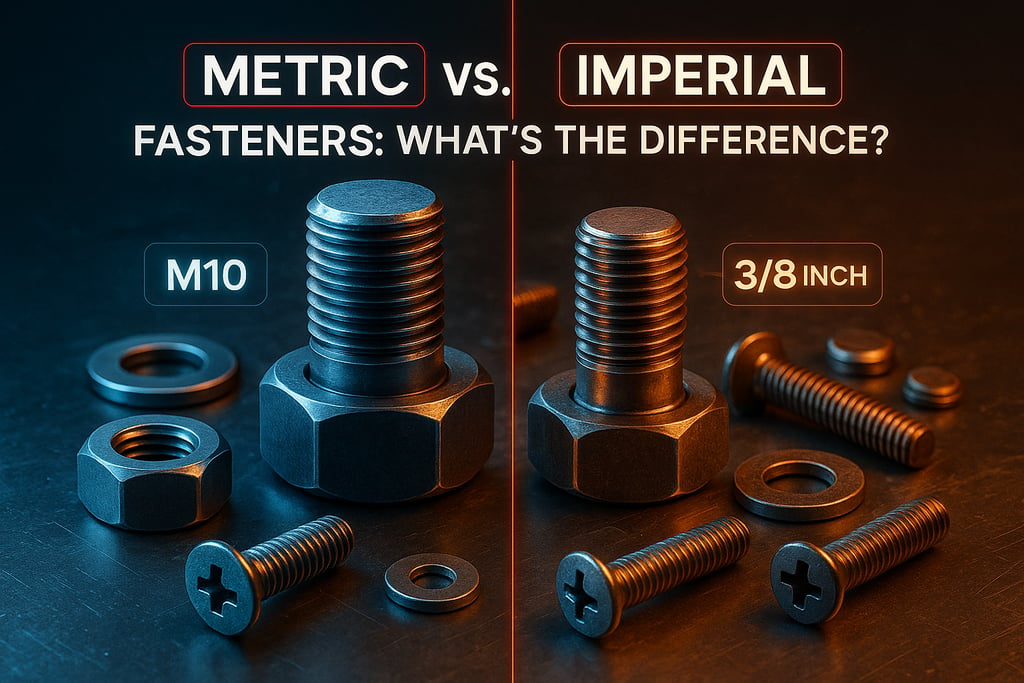Metric vs. Imperial Fasteners: What’s the Difference?
Discover the key differences between metric and imperial fasteners. Learn how to choose the right fastener system for your construction and engineering projects.
GENERAL & INFORMATIVE ARTICLES


Introduction: Why Does the Metric vs. Imperial Fastener Debate Matter to You?
Imagine this scenario: Your engineering team specifies bolts for a major international project. You source the fasteners overseas, but when they arrive, they don’t fit — causing costly delays, rework, and frustration.
Whether you’re an engineer, procurement manager, or industrial buyer, understanding the difference between metric and imperial fasteners is essential for smooth international supply chains. Misunderstanding sizing or compatibility can lead to mismatched parts, compliance issues, and even safety risks.
At Bait Alnuhas, we’ve worked closely with industry leaders worldwide. We know how mastering fastener sizing standards saves you time, money, and hassle. This post breaks down the technical differences, standards, and practical tips to help you specify the right fasteners confidently.
Metric vs. Imperial Fasteners: The Technical Breakdown
What Are Metric and Imperial Fasteners?
Metric Fasteners use the metric system — measurements are in millimeters (mm) for diameter, thread pitch, and length.
Imperial Fasteners use inches or fractions of an inch for size, with thread pitch measured as threads per inch (TPI).
Key Differences You Should Know
Sizing Units:
Metric fasteners measure diameter and length in millimeters (e.g., M10 means 10 mm diameter).
Imperial fasteners measure in inches or fractions (e.g., 3/8” diameter).
Thread Pitch:
Metric threads are spaced by millimeters (e.g., 1.25 mm pitch means distance between threads).
Imperial threads are counted as threads per inch (e.g., 20 TPI means 20 threads per inch).
Standards:
Metric fasteners follow ISO (International Organization for Standardization) and DIN (German Institute for Standardization).
Imperial fasteners follow ANSI (American National Standards Institute) and SAE (Society of Automotive Engineers) standards.
Labeling:
Metric fasteners are marked with “M” plus diameter and pitch (e.g., M8 x 1.25).
Imperial fasteners use fractional diameter and TPI (e.g., 1/4”-20).
Head Markings and Grades:
Metric bolts use ISO codes to indicate strength (e.g., 8.8, 10.9).
Imperial bolts use SAE or ASTM markings for grade.
Interchangeability:
Metric and imperial fasteners are generally not interchangeable due to thread shape, pitch, and size differences. Mixing them risks cross-threading and component damage.
Why These Differences Matter in International Fastener Sourcing
Fit and Function: An M8 bolt (8 mm diameter) won’t fit properly in a 5/16” nut (7.94 mm diameter), and vice versa. Threads that don’t match can damage parts and compromise safety.
Compliance with Standards: Different regions and industries require adherence to specific standards. Using the wrong fastener can lead to project delays, rejected shipments, or failed inspections.
Torque Specifications: Metric and imperial fasteners often require different torque settings, affecting assembly quality and joint integrity.
Labeling Confusion: Incorrect or incomplete specifications can cause incorrect orders — a common issue in cross-border procurement.
Fastener Standards Explained: ISO, ANSI, DIN, and More
Metric Standards
ISO 68-1: Defines metric thread profiles globally.
DIN 931/933: German standards for metric bolts (partial and full thread).
ISO 898-1: Defines mechanical properties and strength classes like 8.8, 10.9.
Imperial Standards
ANSI B18.2.1: Defines inch-series bolts and screws.
SAE J429: Covers mechanical properties of inch-series bolts.
ASTM A307: Carbon steel bolts and studs specification.
Avoiding Costly Mistakes: Practical Tips
Always specify full fastener details: Diameter, length, thread pitch, grade, and applicable standard.
Use clear visual aids or sample parts when communicating specs with suppliers.
Do not assume interchangeability; confirm compatibility before purchase.
Work with expert suppliers like Bait Alnuhas, who understand the nuances of metric and imperial fasteners and offer tailored guidance for international sourcing.
Typical Applications for Metric and Imperial Fasteners
Automotive: Predominantly metric fasteners globally.
Aerospace: Mix of imperial and metric depending on region and equipment origin.
Oil & Gas: Heavy use of imperial fasteners, especially in US-based legacy equipment.
Construction: Varies by region; metric is common in Europe and Asia, imperial in the US and some Middle East countries.
Heavy Machinery: Mixed usage, depending on manufacturer and client specifications.
Why Bait Alnuhas Is Your Trusted UAE Fastener Supplier
With years of experience serving clients across Asia, Europe, Africa, and the Americas, Bait Alnuhas offers:
A comprehensive inventory of both metric and imperial fasteners.
Expert technical consultation to ensure you get exactly what your project requires.
Commitment to quality standards (ISO, ANSI, DIN, ASTM).
Reliable international shipping and logistics to keep your supply chain moving smoothly.
Final Thoughts
Getting fastener specifications right is crucial for engineering integrity, cost control, and project timelines. Knowing the metric vs imperial fasteners difference and the relevant standards can save you from expensive mistakes.
Trust Bait Alnuhas, a top UAE fastener supplier with global expertise, to guide you through the complexity and deliver the right fasteners every time.
Ready to streamline your international fastener sourcing?
Contact Bait Alnuhas today for expert advice and a reliable supply chain partner.
Get in touch now →
